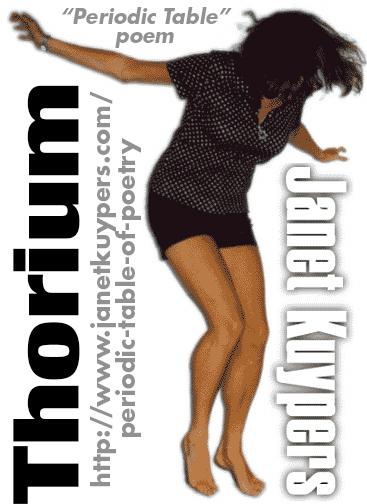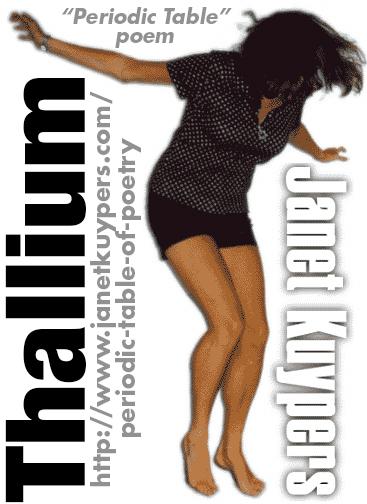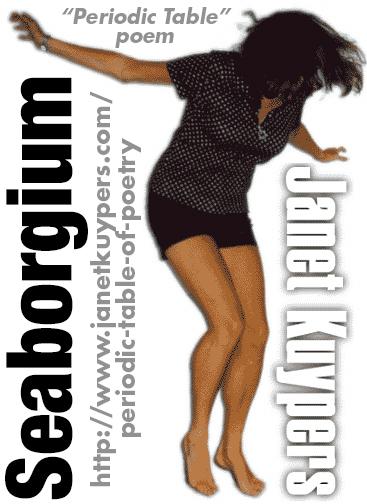Building Houses out of Pallets
on the back of a touring bike
unmarried women and dead bodies everywhere
Visakhapatnam
poor
unless
don’t
cover
imprisoned / ignorance
extend
Quoting twitter with a found haiku
choice
Us Creative Types
JY asks
Thorium
Janet Kuypers

from the “Periodic Table of Poetry” series (#90. Th)
7/1/14
Think of how many times
you’ve heard scientists say
(or maybe you’ve heard it
from people on daredevil tv)
“do not try this at home” —
knowing that someone,
somewhere
won’t heed this advice
and end up
with an unintended explosion
instead of a fantastic discovery
from their radical experiment…
Well, good thing one Swedish chemist
didn’t decide to “not try this at home”,
doing groundbreaking experiments
in his kitchen flat.
Though Jöns Jacob Berzelius < !—(yens yoke-ub bear-zeal-ee-us)—>
discovered a few elements,
he seemed so psyched
to name one new element
for the Scandinavian god of thunder, Thor.
And it’s kind of funny
that with his affinity for Thorium,
he never understood
Thorium’s radioactivity
(because, well,
when he discovered Thorium,
radioactivity hadn’t
even been discovered yet).
But after Thorium was discovered,
Thorium was used
for powering gas lamps
back in the day
when the world’s light
disappeared at nightfall.
But wait, Thorium’s radioactive,
and back in the day
they didn’t know this,
so did people get cancer
from radiation poisoning?
Well, maybe if
there was enough Thorium
in those gas lamps,
and maybe if that Thorium
wasn’t stopped from
getting to humans
by the glass surrounding the lamps…
Because only if you’d
eat Thorium (and maybe
only the supernatural God Thor
would eat Thorium)
maybe only if you ate it
only then might it make you sick.
I mean, they still sell it
today in camping lamps,
unless you actually look for a lamp
that’s Thorium-free…
But even when it came
to eating Thorium,
some people would do it
back in the ‘30s with x-rays
for detecting their cancer,
because at the time Thorium
was perfect for saving lives
thanks to those x-rays.
So with Thorium for cancer x-rays,
the new cancer risk
seemed like a fair trade-off
before they could find
a safer x-ray detection agent.
So yeah, there’s no way
a Swedish chemist
could have guessed it
when he discovered
the element Thorium
and wanted to name it
after the God of Thunder,
but Thorium can bring
some light into our world,
as long as we use Thorium
in just the right way.
Janet Kuypers reading her poem “New to Chicago” from memory live 3/4/15 at the open mic the Café Gallery in Chicago (Canon fs200)
“new to chicago”
(poem by Jaet Kuypers)
I’m still new to this city
I know, I know, I’ve been here for years
but I haven’t gone to the Sears Tower Observatory
since my Junior Prom
but when I walk by the First Chicago building
the beams along the north side
sloping up, parabolic pillars curving up to the sky
when I walk by the First Chicago building
I walk up along the side
and lean up against one of the sloping pillars
press my body against the cold concrete
feel the cold against my chin, my breasts, by thighs
and look up along the curve, stretching up towards the sky
you know, these pillars look like race tracks
and I could see something come rushing down that curve
a matchbox car, a race car
a marble, a bowling ball
a two-ton weight
I see the speed, the power, and it
almost makes me afraid to look up
and every time I walk by the First Chicago building
I do the same thing, I do this little ritual
and it feels like the first time
Janet Kuypers reading her poem “New to Chicago” from memory live 3/4/15 at the open mic the Café Gallery in Chicago (Canon Power Shot)
Janet Kuypers reads portions of her India Journals< (from 20150111 9:25PM IST) at the open mic the Café Gallery in Chicago (Canon fs200)
Janet Kuypers reading William F. Meyer Jr.’s poem “Cave Woman / Cave Man Soliloquy I” from the Down in the Dirt collection book What Must be Done live 3/4/15 at the open mic the Café Gallery in Chicago
Janet Kuypers reading Catherine B. Krause’s “The Herd” from the current issue of cc&d magazine’s “the Curve of Arctic Air” live 3/4/15 at the open mic the Café Gallery in Chicago
Janet Kuypers reading Robert Bates’ prose “Knockout” from Down in the Dirt mag (the Jan./Feb. 2015 issue, v127) titled “Treading Water” live 3/4/15 at the open mic the Café Gallery in Chicago
Janet Kuypers reading C Ra McGuirt’s poem “If you read this poem, then you will die” from the 2015 “need to know” literary date book live 3/4/15 at the open mic the Café Gallery in Chicago
Janet Kuypers reading Rex Sexton’s poem “this is not a poem” from the 2015 “need to know” literary date book live 3/4/15 at the open mic the Café Gallery in Chicago
See YouTube video
of Janet Kuypers hosting the open mic 3/4/15 at Gallery Cabaret’s the Café Gallery in Chicago
Thallium
Janet Kuypers

from the “Periodic Table of Poetry” series (#81, Tl)
started 2/7/14, finished 2/8/14
I swirled the wine glass in my hand.
I watched the red wine swirl,
creeping it’s way to the lip
as I hypnotically observe the vortex.
I like drinking my red wine from those
low, wide-mouthed glasses
so you could smell the sweet aroma
without even drinking. But now,
now I check my fingernails,
looking for dark ridges. I wonder if I
should pull out a few hairs
and check the roots for telltale stripes.
I scan my brain to check if I have enemies,
the coast seems clear, but still I fear
that this precious liquid I hold in my hand
could be the vehicle for my demise.
And no, my liver’s fine, it was just tested,
and I’m not talking about alcohol poisoning
unless it’s because someone put something
in my drink I wouldn’t taste, or smell, or see.
But my brain now flashes to Thallium,
this superconductor, once used to treat
syphilis, gonorrhea, or even tuberculosis
is such a highly toxic heavy metal
that it was used for rat poisoning,
and sometimes even for hair removal
(yeah, trace amounts of Thallium can even
make you lose your hair). But the thing is,
I’ve heard that if you drop it into somethnig like,
say, red wine, no one would be the wiser
and you could kill someone without your victim
even knowing they were ever in danger.
If I keep this up, I’ll really start to worry
whenever my stomach hurts, whenever I feel
nauseous, or even have diarrhea.
If I feel numbness, or tingling and pain,
I’ll second-guess myself. I’ll have to check
the shower drain for excessive hair loss,
and I’ll check my fingernails and follicles again
to make sure I’m in the clear.
Seaborgium
Janet Kuypers

from the “Periodic Table of Poetry” series (#105, Sg)
7/28/14 (started 7/27/14)
I’ve always loved the sea.
When standing at these Pacific shores
I’m always intoxicated by the action there,
at the vibrancy, the sense of life.
I’ve always been drawn to the idea of learning,
to California’s desire to explore and discover.
#
There was a scientist, Glenn Seaborg,
who later worked through U of C Berkeley.
And when it comes to discovery in California,
Seaborg really had a hold on the chemistry market.
Because during his career, he did theoretical work
in the development of the Actinide series
in the Periodic Table, and he even helped discover
ten elements (many in that Actinide series).
But one element that wasn’t in the Actinides series
that he helped discover, element one oh six,
that was the element people petitioned
to be named after him (you know, because
of all he had discovered for the Periodic Table).
But scientists in Dubna Russia were also wanting
to claim the naming rights for element one oh six,
and naming this element after Seaborg
caused quite a stir, because elements
are only named after dead people, they said.
But the Americans actually pulled it off
and got the new element named Seaborgium.
Transuranium elements like Seaborgium
are only artificially made with particle accelerators,
and I know those scientists,
after finding elements that way
only acquire one or two atoms,
and they can only guess the element’s properties
by their location on the Periodic Table…
I mean, Seaborgium’s isotopes
have half lives only seconds long,
and there’s no use we know of for Seaborgium
other than scientific research
(like for scientists like Seaborg or Albert Ghiorso,
or the leader of that Seaborgium discovery team).
But after the element was named Seaborgium,
and since Seaborgium is the only element
named after a living person,
it may have been possible
to send Glenn Seaborg a letter
addressed in chemical elements:
send it to Seaborgium,
in lawrencium (for his Lawrence Berkeley Lab),
in the city berkelium,
in the state californium,
and
(if the letter’s being mailed
from outside the U.S.)
in the country americium…
I don’t know if any letters like this
actually got through to him,
but for a man with that many
discoveries under his belt,
sending letters to him
using only Periodic Table elements
almost seems like icing on the cake.